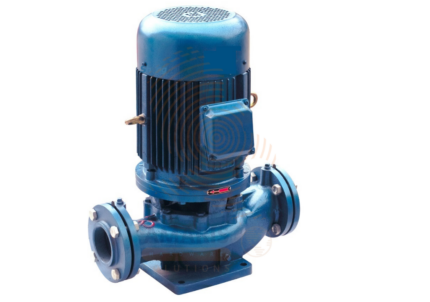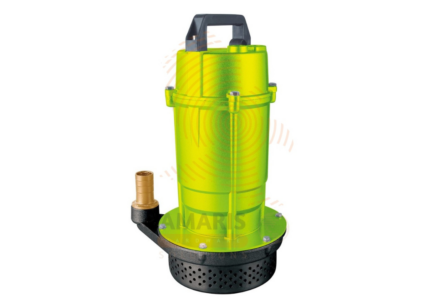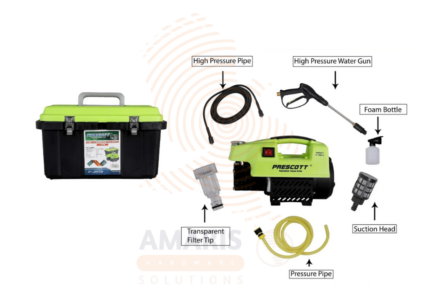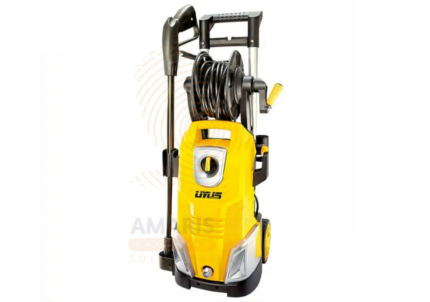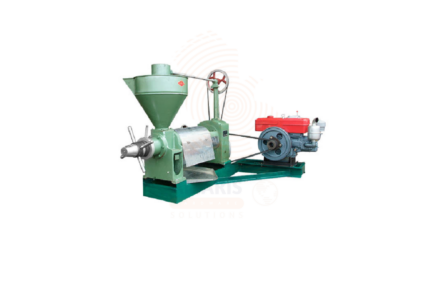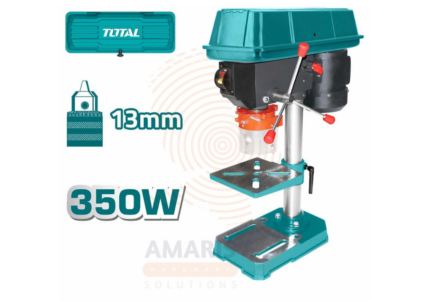
Drill Press
$115.38 Original price was: $115.38.$109.61Current price is: $109.61.
Hose for Air Compressor
WhatsApp Order
PRODUCT DESCRIPTION
A hose for an air compressor is a flexible and durable conduit designed to connect the air compressor to pneumatic tools, equipment, or other devices requiring compressed air. Typically made of materials such as rubber, PVC, or hybrid blends, these hoses are capable of withstanding high pressure and provide a pathway for the compressed air to flow from the compressor to the intended application. The hose facilitates the efficient and controlled transfer of compressed air, enabling various pneumatic tools and devices to operate effectively in a wide range of industrial, automotive, and household applications.
Description
Uses of a HOSE FOR AIR COMPRESSOR
- Powering Pneumatic Tools:
- Hoses are crucial for connecting air compressors to pneumatic tools such as impact wrenches, nail guns, air drills, grinders, and sanders. The compressed air is used to power these tools, making them versatile and efficient.
- Spray Painting:
- Air compressors, along with hoses, are commonly used for spray painting applications. The compressed air helps atomize paint particles, providing a smooth and even coating on surfaces.
- Inflating Tires and Sports Equipment:
- Hoses are used to connect air compressors to inflation devices, making it easy to inflate tires, sports balls, inflatable toys, and other items.
- Cleaning and Dusting:
- Air compressors, when connected to hoses with appropriate nozzles, can be used for blowing away dust and debris from surfaces and equipment. This is common in workshops and industrial settings.
- Sandblasting:
- For tasks such as cleaning and surface preparation, sandblasting equipment is connected to air compressors via hoses. The high-pressure air is used to propel abrasive materials for cleaning or etching surfaces.
- Pneumatic Systems in Manufacturing:
- Industries use air compressors and hoses to power pneumatic systems for automation, control systems, and various manufacturing processes.
- HVAC Systems:
- Air compressors, along with hoses, are employed in the maintenance and installation of heating, ventilation, and air conditioning (HVAC) systems.
- Medical Equipment:
- Certain medical devices, like dental chairs or surgical tools, may be powered by compressed air delivered through hoses.
- Construction and Carpentry:
- Pneumatic nail guns, staplers, and other tools used in construction and carpentry are connected to air compressors via hoses.
- Pressure Testing:
- Hoses are utilized in pressure testing applications where a controlled and pressurized air supply is needed to test the integrity of pipes, containers, or other sealed systems.
SAFETY HANDLING PRECAUTIONS
Safety Measures and Precautions
- Inspect the Hose Regularly:
- Before each use, inspect the hose for any signs of wear, damage, or leaks. Replace damaged hoses promptly to prevent accidents.
- Use the Right Hose for the Job:
- Ensure that the hose is suitable for the specific application, taking into account factors such as pressure rating, temperature range, and compatibility with the type of air being compressed.
- Check Fittings and Connections:
- Inspect fittings and connections for tightness and secure attachment. Loose fittings can lead to leaks or sudden hose disconnection.
- Use Adequate Personal Protective Equipment (PPE):
- Depending on the application, wear appropriate PPE such as safety glasses, ear protection, and gloves to protect against potential hazards.
- Follow Manufacturer's Guidelines:
- Adhere to the manufacturer's recommendations and guidelines for the air compressor and hose. This includes information on pressure ratings, usage limitations, and maintenance procedures.
- Secure Hose Positioning:
- Securely anchor or support the hose to prevent it from whipping or kinking during use. This is particularly important when working with high-pressure air.
- Bleed Air Pressure Before Disconnecting:
- Before disconnecting the hose or making any adjustments, bleed off the air pressure in the system to avoid sudden release of compressed air.
- Maintain a Safe Distance:
- Keep a safe distance from the point of use, especially when using pneumatic tools. This precaution helps prevent injuries in case of unexpected hose disconnection or tool malfunction.
- Avoid Over-Pressurization:
- Do not exceed the recommended pressure limits of the hose. Over-pressurization can lead to hose failure, posing a significant safety risk.
- Educate Users:
- Ensure that all individuals using the air compressor and hose are properly trained on its safe operation. Emphasize the importance of following safety guidelines.
- Store Hoses Properly:
- When not in use, store hoses in a clean and dry environment away from direct sunlight and potential sources of damage.
- Emergency Response Plan:
- Develop and communicate an emergency response plan in case of accidents, including procedures for shutting off the air compressor and administering first aid.
Related products
Booster Pump
A booster pump is a mechanical device designed to increase the pressure of fluids, typically water, in plumbing and irrigation systems. It ensures adequate water pressure for residential, commercial, and industrial applications where existing pressure is insufficient. Booster pumps help maintain consistent flow rates and enhance system performance by compensating for pressure drops caused by elevation, friction, or demand fluctuations. They are essential in water supply systems, HVAC, and various manufacturing processes.
Clean Water Submersible Pump
The Clean Water Submersible Pump is designed for efficient water transfer in residential, commercial, and light industrial applications. Engineered to handle clean, debris-free water, this submersible pump ensures reliable performance, high flow rates, and long-lasting durability. Its compact design allows for easy installation in wells, tanks, and sumps, while the corrosion-resistant materials provide enhanced longevity. Ideal for irrigation, water supply, and drainage tasks, this pump combines efficiency with quiet operation, making it a dependable solution for your water handling needs.
High Pressure Hose
A High Pressure Hose is a flexible and reinforced conduit designed to transport fluids, such as water, oil, or gas, under elevated pressure levels. Typically constructed with durable materials, such as synthetic rubber or thermoplastic compounds, high-pressure hoses are engineered to withstand and contain the force exerted by the fluid they convey. These hoses are commonly used in various industrial, automotive, and hydraulic applications where the need for efficient and secure fluid transfer at elevated pressures is paramount.
High Pressure Washer Heavy Duty Packed in a Case
The High Pressure Washer Heavy Duty Packed in a Case is designed for efficient and powerful cleaning tasks. Ideal for both residential and commercial use, this washer delivers high water pressure to remove dirt, grime, and stains from various surfaces including driveways, vehicles, patios, and outdoor equipment. The compact case ensures easy storage and portability, while robust construction guarantees long-lasting performance. Equipped with adjustable nozzles and user-friendly controls, it provides versatility and precision for a wide range of cleaning applications.
Induction Motor Brushless Pressure Washer
The Induction Motor Brushless Pressure Washer is a high-performance cleaning tool designed for demanding tasks in both residential and industrial environments. Powered by a durable brushless induction motor, it delivers consistent, high-pressure water output for effective removal of dirt, grime, and stains on vehicles, driveways, machinery, and outdoor surfaces. Its brushless technology ensures quieter operation, longer motor life, and improved energy efficiency. Built with rugged components and ergonomic features, this pressure washer is ideal for users who require power, reliability, and low maintenance.
Oil Expeller
An Oil Expeller is a mechanical device used to extract oil from oil-bearing seeds and nuts through a process of high-pressure mechanical pressing. It typically consists of a screw shaft, pressing chamber, and power system (manual, electric, or engine-driven), and is widely used in small-scale farms, local oil mills, and commercial processing units. Capable of handling materials like sunflower seeds, groundnuts, soybeans, mustard, coconut, and sesame, oil expellers are available in both cold press and hot press variants. This machine enables efficient, chemical-free oil extraction, producing unrefined oil and residual seed cake for further use.
Pipe Wrench
PRODUCT DESCRIPTION
A pipe wrench is a hand tool designed for gripping and turning pipes or cylindrical objects. It typically consists of a long handle and adjustable jaws, allowing it to securely grasp pipes of various sizes. The jaws have serrated teeth that provide a firm grip, making it easier to tighten, loosen, or hold pipes during plumbing or other related tasks. Pipe wrenches are commonly used in plumbing and construction work to manipulate and secure pipes and fittings.
Tubing Cutter and Flaring Tool Set
This Tubing Cutter and Flaring Tool Set is an essential kit for plumbing, HVAC, and automotive applications, designed to provide precise and clean cuts along with professional-quality flares on tubing. The set includes a durable tubing cutter that easily slices through copper, aluminum, and soft steel pipes with minimal effort and a flaring tool that creates accurate, leak-proof flares to ensure tight fittings. Compact and easy to use, this kit is ideal for both professionals and DIY enthusiasts looking for reliable performance and lasting durability. Its ergonomic design and sturdy construction make tubing preparation efficient, helping you achieve secure connections every time.


 Acrylic Sealants
Acrylic Sealants Construction Adhesives
Construction Adhesives Double-Sided Tape
Double-Sided Tape Duct Tape
Duct Tape Electrical Tape
Electrical Tape Epoxy & Resins
Epoxy & Resins Masking Tape
Masking Tape
 Automotive Wrenches & Socket Sets
Automotive Wrenches & Socket Sets Battery Chargers & Jump Starters
Battery Chargers & Jump Starters Car Jacks & Stands
Car Jacks & Stands Car Wash & Detailing Products
Car Wash & Detailing Products Diagnostic Tools
Diagnostic Tools Tire Inflators
Tire Inflators Vehicle Lighting
Vehicle Lighting Oil & Lubricants
Oil & Lubricants
 Adhesives & Sealants
Adhesives & Sealants Bricks & Blocks
Bricks & Blocks Cement & Concrete
Cement & Concrete Drywall & Plaster
Drywall & Plaster Flooring (Tiles, Wood, Laminate)
Flooring (Tiles, Wood, Laminate) Lumber & Plywood
Lumber & Plywood Paints, Primers & Coatings
Paints, Primers & Coatings Insulation Materials
Insulation Materials Roofing Materials
Roofing Materials
 Circuit Breakers
Circuit Breakers Electrical Cables & Wires
Electrical Cables & Wires Switches & Sockets
Switches & Sockets Fuses & Relays
Fuses & Relays Connectors & Terminals
Connectors & Terminals Electrical Boxes & Panels
Electrical Boxes & Panels Conduit & Fittings
Conduit & Fittings Lighting Fixtures & Bulbs
Lighting Fixtures & Bulbs Extension Cords & Power Strips
Extension Cords & Power Strips
 Anchors
Anchors Bolts
Bolts Clips & Clamps
Clips & Clamps Screws
Screws Nuts
Nuts Washers
Washers Rivets
Rivets Nails
Nails Threaded Rods
Threaded Rods
 Hammers
Hammers Measuring Tools (Tapes, Levels, Calipers)
Measuring Tools (Tapes, Levels, Calipers) Screwdrivers
Screwdrivers Pliers & Cutters
Pliers & Cutters Saws & Blades
Saws & Blades Chisels & Punches
Chisels & Punches Allen Keys & Hex Keys
Allen Keys & Hex Keys Ratchets & Socket Sets
Ratchets & Socket Sets Wrenches & Spanners
Wrenches & Spanners
 Power Tool Accessories (Blades, Bits, Discs)
Power Tool Accessories (Blades, Bits, Discs) Rotary Tools
Rotary Tools Saws (Circular, Jigsaw, Reciprocating)
Saws (Circular, Jigsaw, Reciprocating) Drills & Drivers
Drills & Drivers Grinders & Sanders
Grinders & Sanders Heat Guns
Heat Guns Nail Guns
Nail Guns Impact Wrenches
Impact Wrenches Batteries & Chargers
Batteries & Chargers
 Pipes & Fittings (PVC, Copper, PEX)
Pipes & Fittings (PVC, Copper, PEX) Plumbing Tools
Plumbing Tools Pumps & Motors
Pumps & Motors Sealants & Adhesives for Plumbing
Sealants & Adhesives for Plumbing Valves & Taps
Valves & Taps Water Heaters
Water Heaters Drainage Systems
Drainage Systems Faucets & Fixtures
Faucets & Fixtures Hoses & Tubing
Hoses & Tubing
 Hinges & Latches
Hinges & Latches Hooks & Brackets
Hooks & Brackets Window Hardware
Window Hardware Chains & Cables
Chains & Cables Casters & Wheels
Casters & Wheels Shelving & Storage Systems
Shelving & Storage Systems Door Handles & Locks
Door Handles & Locks Drawer Slides & Cabinet Hardware
Drawer Slides & Cabinet Hardware
 Personal Protective Equipment (PPE)
Personal Protective Equipment (PPE) Respirators & Masks
Respirators & Masks Safety Glasses
Safety Glasses Safes
Safes Security Cameras
Security Cameras Gloves
Gloves Helmets
Helmets Ear Protection
Ear Protection Fire Safety Equipment
Fire Safety Equipment Locks & Padlocks
Locks & Padlocks Motion Sensors & Alarms
Motion Sensors & Alarms
 Garden Fencing
Garden Fencing Garden Furniture Hardware
Garden Furniture Hardware Lawn Mowers
Lawn Mowers Trimmers & Edgers
Trimmers & Edgers Shovels & Spades
Shovels & Spades Rakes & Hoes
Rakes & Hoes Pruning Shears & Loppers
Pruning Shears & Loppers Watering Systems (Hoses, Sprinklers, Nozzles)
Watering Systems (Hoses, Sprinklers, Nozzles)
 Interior Paints
Interior Paints Paint Brushes & Rollers
Paint Brushes & Rollers Paint Strippers & Thinners
Paint Strippers & Thinners Paint Trays & Accessories
Paint Trays & Accessories Exterior Paints
Exterior Paints Spray Paints
Spray Paints Primers & Undercoats
Primers & Undercoats Varnishes & Stains
Varnishes & Stains
 Gaskets & Seals
Gaskets & Seals Hydraulic Fittings
Hydraulic Fittings Industrial Fasteners
Industrial Fasteners Industrial Hoses
Industrial Hoses Lubricants & Greases
Lubricants & Greases Metal Sheets & Bars
Metal Sheets & Bars Bearings & Bushings
Bearings & Bushings Belts & Pulleys
Belts & Pulleys
 HVAC Filters
HVAC Filters Insulation for HVAC
Insulation for HVAC Air Conditioners
Air Conditioners Refrigerants
Refrigerants Ventilation Ducts & Fittings
Ventilation Ducts & Fittings Thermostats & Controllers
Thermostats & Controllers Fans & Blowers
Fans & Blowers
 Pegboards & Hooks
Pegboards & Hooks Shelving Units
Shelving Units Storage Bins & Containers
Storage Bins & Containers Toolboxes & Tool Chests
Toolboxes & Tool Chests Workbenches
Workbenches Drawer Organizers
Drawer Organizers Labeling Supplies
Labeling Supplies
 Welding Accessories (Clamps, Brushes)
Welding Accessories (Clamps, Brushes) Welding Electrodes & Rods
Welding Electrodes & Rods Welding Helmets & Gloves
Welding Helmets & Gloves Welding Machines
Welding Machines Soldering Irons & Stations
Soldering Irons & Stations Flux & Solder Wire
Flux & Solder Wire
 Generator Accessories
Generator Accessories Inverters
Inverters Portable Generators
Portable Generators Power Inverters
Power Inverters Transfer Switches
Transfer Switches Diesel & Gasoline Generators
Diesel & Gasoline Generators
 Transport Equipment: Carts, Dollies, and Hand Trucks
Transport Equipment: Carts, Dollies, and Hand Trucks Storage Solutions: Pallets, Racks, and Containers
Storage Solutions: Pallets, Racks, and Containers Lifting Equipment: Hoists, Cranes, and Jacks
Lifting Equipment: Hoists, Cranes, and Jacks Conveyors and Accessories: Belts and Rollers
Conveyors and Accessories: Belts and Rollers

